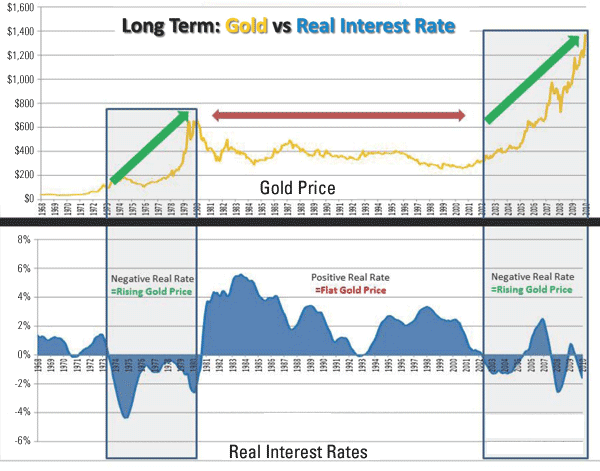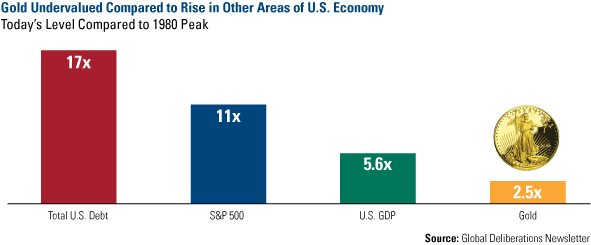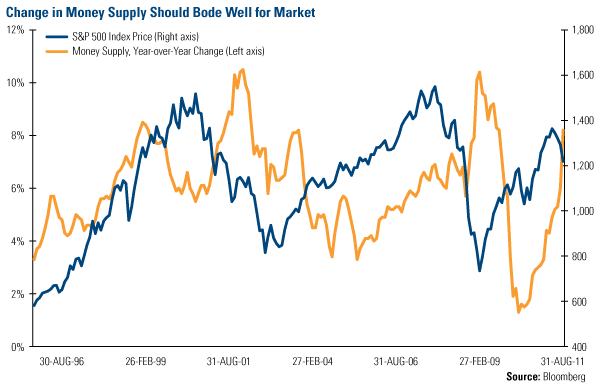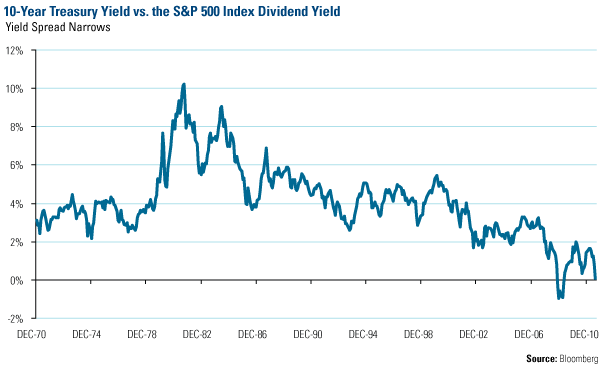
Of course, the fiscal situation is more complicated when it comes to a “family” of 311 million. It is only one part of a large conundrum for the global economy.
Gold is “Sole Beneficiary” in this Economy
Don Coxe, global portfolio strategist, points to the Shanghai Composite Index and Bombay Sensex which are currently at one-year lows, indicating that investors are not feeling confident even in these relatively strong markets where GDP is growing. In this environment, Coxe believes gold is the “sole beneficiary.”
We’ve discussed several times that another driver of gold prices has been real interest rates. Take a look at the chart from Gold Stock Analyst (GSA) depicting the price of gold going back to 1968. In each case when real rates (calculated by subtracted the 12-month moving average of the year-over-year change of CPI from the 12-month moving average of the 3-month Treasury bill) went negative—in the 1970s, the first years of the new decade, and off and on from 2008 until now—gold has had a dramatic rise in price.
A negative real interest rate means that a hypothetical $100 investment in a T-bill is worth, for example, $98.90 a year later, i.e. you’ve lost purchasing power. Investors seeking yield have fled to gold in these instances.

Despite gold’s dramatic bull run over the last 10 years, the yellow metal is only twice as high as its 1980 price. In comparison to other economic yardsticks since 1980, this is miniscule. Ian McAvity, editor of Deliberations on World Markets, says that federal debt, the S&P 500 Index and even GDP has grown much faster than gold over that same timeframe.

McAvity extrapolates the relative growth rate of the yellow metal, indicating that if gold doubled from its current high, it “would nearly ‘catch up’ to GDP, while it might take a quadruple to match the S&P, or even a six-fold gain from here to catch the growth of debt.” Multiplying the largest of these figures by the current price of gold means prices could theoretically go to $10,800. By these standards, gold is hardly a bubble.
Gold these days has become so “legitimized,” helped by negative real interest rates, that the metal now directly competes with stocks for a share of investors’ portfolios, says the GSA. We applaud this development, as we have always thought investors should allocate a small portion of their portfolio to gold. However, we argue that a gold ETF is not always a wise choice, particularly when it is treated as a short-term trade, like a stock.
As we’ve indicated many times in recent months, a better opportunity for gold investors appears to be in gold mining companies. Coxe agrees, as he believes today represents the “greatest devaluation of precious metal stocks.” In his experience, he thinks there has never been such a disparity in precious metals stocks compared to the price of gold. There are two reasons for this: In the 1970s, the gold ETF did not exist, so speculators who wanted gold exposure had to purchase bullion and take physical possession of it or purchase gold mining shares. Also, gold miners have faced higher labor and energy costs as well as increased capital expenditures.
Coxe also brought to our attention the Investor’s Business Daily’s Industry Sub-Group Rankings, which lists six-month performance to help investors identify potential growing areas of the economy. Out of 197 groups, the third-ranking member on the list was gold mining companies.
Over the last several weeks, gold has received a lot of attention and we’ve discussed gold stocks and gold bullion quite often. If you were out trying to squeeze in one last summer vacation, here’s what you missed:
- Valuation Gap Makes Gold Miners Attractive But All Miners Aren’t Created Equal
- The Neverending Story of a “Gold Bubble”
- Will Gold Equity Investors Strike Gold?
Two Recent Developments for U.S. Stocks
What hasn’t gotten a lot of attention in the media is growing money supply. Instead, much of the media has focused on day-to-day, even hour-to-hour, data. However, it is a key lubricant of the economy and financial markets.
The Federal Reserve influences money supply growth, and as can be seen in the chart below, money supply often spikes during crisis or uncertainty, such as Y2K, 9/11, the collapse of Lehman Brothers and the ensuing financial crisis. The current environment of sluggish growth, government austerity and worries over the European banking sector has likely influenced the dramatic rise in money supply over the past 18 months. The Fed likely errs on the side of caution to stimulate growth as inflation is not currently a concern.

Equities look particularly attractive relative to bonds, especially today. During the last 40 years, the yield on the S&P 500 has rarely exceeded the yield on the 10-year Treasury bond.

It’s worth repeating the famous quote from Baron Rothschild, an 18th century British nobleman and member of the Rothschild banking family, who is credited with saying that “the time to buy is when there's blood in the streets.”
It has been “bloody” recently and that is precisely the time to have the courage to make long-term investments at favorable prices.







No comments:
Post a Comment